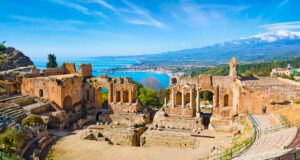Casa Cuseni was the residence in Taormina of the English painter Robert Hawthorn Kitson. It is a small architectural jewel set in a historical garden of great artistic and cultural value. Inside the house, in the dining room, Sir Frank Brangwyn, one of the first decorators of L.C. Tiffany, created an Arts and Crafts mural dedicated to Kitson, his companion Carlo Siligato and Francesco, an orphan adopted by them.
The history of Casa Cuseni
Casa Cuseni was the villa in Taormina of the English painter Robert Hawthorn Kitson. The building was constructed in three years, between 1902 and 1905, and was designed by himself. Starting in 1905, Robert Kitson transformed Casa Cuseni into an international center for applied arts. In 1947, after Kitson’s death, the house was inherited by his nephew, Daphne Phelps, who turned part of the residence into a museum dedicated to her painter uncle. The other part became the first hotel for artists in Europe, which still operates today with five rooms. In 2016, this historic house was officially included in the “Casa della Memoria” (House of Memory)” circuit, hich brings together the house museums in Italy where illustrious people from all fields of knowledge, art, literature, science and history lived. Also in 2016, the garden of Casa Cuseni received an important recognition by being included in the circuit of “Grandi Giardini d’Italia” (“Great Italian Gardens“). Since 2017 Casa Cuseni is the home of the International Foundation dedicated to the painter Robert Hawthorn Kitson.
Who was Robert Hawthorn Kitson
Robert Hawthorn Kitson was an English painter born in Leeds. His works are now exhibited at the Victoria and Albert Museum in London, the Leeds University Library and the Herbert F. Johnson Museum of Art. After studying at the Shrewsbury School and Trinity College, Cambridge, he moved to Taormina in 1900 for a period of convalescence after a bout of rheumatic fever. Here Kitson fell in love with the town and Sicily and decided to move there permanently, designing his own house. A collector of paintings and works of art of various kinds, a connoisseur of contemporary English art and an excellent watercolorist, in 1905 Kitson transformed his house into the International Center for Applied Arts, which was frequented by such illustrious figures as Pablo Picasso, Salvador Dali, Bertrand Russell and Greta Garbo.
The architecture of Casa Cuseni
To build Casa Cuseni, Robert Hawthorn Kitson chose a steep hill just outside the center of Taormina. The choice was not accidental; in fact, the location offers a splendid view of the sea and Mount Etna. In designing the house, the painter was inspired by Italian Renaissance villas, particularly Palladian villas. The architecture of Casa Cuseni consists of a rectangular structure with two slightly protruding symmetrical wings connected by a colonnade supporting a terrace. Inside, there is a wide hall flanked by two square rooms. One of them is the so-called Dining Room, a small masterpiece of Arts and Crafts.
The Dining Room and the Sir Frank Brangwyn Mural
The Dining Room at Casa Cuseni is the only surviving interior in the world designed by Belgian artist Sir Frank Brangwyn, one of L.C. Tiffany’s early decorators. The room is a magnificent example of Arts and Crafts, a movement born in England that sought to reform the applied arts in response to the standardization of everyday objects. Brangwyn designed the room’s furniture and light walnut gilded lambris, as well as the murals that adorn the walls, in 1910. They remained hidden until 2012, however, because of the sensitive subject of homogeneity. Brangwyn portrays Kitson and his partner, the painter Carlo Siligato, holding an infant. In 1908, when the city of Messina was completely destroyed by an earthquake, the couple decided to adopt an orphaned infant named Francesco.
The historical garden of Casa Cuseni
The garden of Casa Cuseni is another setting that makes this house truly unique. The garden was also designed by Kitson, but with the assistance of Sir Frank Brangwyn, Sir Alfred East, Cecil Arthur Hunt, and the futurists Giacomo Balla and Fortunato Depero. The designers created a terraced garden of varying levels and increasing steepness, connected by ramps, steps and paths. The area behind the house is paved with mosaic cobblestones, perfectly embodying the dictates of Arts and Crafts. From here a small path leads to a swimming pool surrounded by a pergola and designed to reflect the summit of Mount Etna in the water. The presence in the garden of a large menorah, three mikvehs and a purification temple, combined with African plants, English roses and Sicilian citrus fruits, make this corner of Taormina a small earthly paradise out of time.
How to visit Casa Cuseni
As of 2015, Casa Cuseni is officially a museum in Taormina with the name “Casa Cuseni, Museum of Fine Arts and the Grand Tour of the City of Taormina”. Guided tours take place daily at 11:30 a.m. and last 60-90 minutes. Tours are in English from Monday to Friday and in Italian on Saturdays and Sundays. Reservations are required. Also part of the Kitson Foundation is the Casa Cuseni Book Collection. This consists of: an antique collection, a modern collection specializing in arts and crafts movements and literature, and material of a more archival nature.
Aggiungi ai preferiti





























